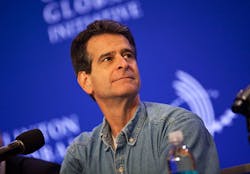Super Inventor's Next Act: Regenerative Manufacturing
It almost takes a force of nature to move an idea from the lab to the factory.
Luckily for regenerative medicine that force of nature, in the form of Dean Kamen, is on the job.
Kamen, who might be best known as the creator of the Segway or the FIRST Robotics competition, actually has a very long history of creating medical devices.
While still in college, he invented the first wearable infusion pump, which was used in the fields of chemotherapy, neonatology, and endocrinology. In 1976, he founded AutoSyringe, Inc., to manufacture the pumps and at age 30, he sold that company to Baxter International Corp. By then, he had added a number of other infusion devices, including the first wearable insulin pump for diabetics.
Next, he founded DEKA Research & Development Corp. which developed HomeChoice, a peritoneal dialysis system which allowed patients to be dialyzed in their home. And at the request of DARPA Kamen also created Luke, an advanced prosthetic arm in for injured soldiers. He invented the iBOT (electric wheelchair) and most recently created Slingshot a water purification device that is installed across the world.
Kamen talked to IndustryWeek to explain how his vision for bringing regenerative medicine to full-scale production led him to find the necessary resources and leadership that culminated in the creation of Advanced Manufacturing Regenerative Institute/BIOFabUSA.
In creating any industry the vision must come first.
"As a society, we have advanced through the four stages of dealing with disease," Kamen explained. "The first is to identify the disease and in this stage, we basically watched people die and then figured out what the disease was. The second stage is learning how to treat disease. This is an improvement, but not optimal. The third stage is to become more active, for example when we are able to transplant organs. But it’s the fourth stage where the future lies. It’s where we prevent disease, for example using vaccines. And in the case of regenerative medicine, we build new organs from our own cells. That’s the optimal solution."
Building organs in the lab is not the stuff of fiction, it’s happening right now. Across the country in many labs, scientists have been working hard to create tissue and pieces of organs, through 3D printing. The advancements, supported by both private and government funding have been gaining quickly.
The Current State of Industry
One of the first big breakthroughs was in 2006 when Dr. Anthony Atala, director of the Wake Forest Institute for Regenerative Medicine in Winston Salem, N.C. made history by growing and implanting a bladder into a human patient – the first time such a feat had ever been accomplished.
Currently, Dr. Alala uses patients own tissue and expand the cells outside of the body creating new tissues and organs that can be put back into the body. The 3D printer creates customized scaffolding that enables the process.
In 2016 researchers at Wake Forest Baptist Medical Center announced that they had printed ear, bone and muscle structures and successfully implanted them into animals. The structures, after being implanted, matured into functional tissue and sprouted new systems of blood vessels, and their strength and size mean that they could feasibly be implanted into humans in the future.
The need for these organs cannot be understated. Every 30 seconds a patient who could have been saved with tissue replacement dies.
Science has been marching on and at the close of 2016, there were 804 clinical trials underway, with numerous approved and/or marketed products worldwide, and many approved to be marketed in specific regions and countries, according to the Alliance for Regenerative Medicine. The group has a list of products that have been approved by internationally-recognized regulatory agencies, as well as products brought to market in the U.S. under The Food, Drug and Cosmetic Act and The Public Health Service Act.
Moving From the Lab to the Factory
"The research community has done a tremendous job in developing the field of regenerative biology," says Kamen. There have been significant breakthroughs in cell biology, biofabrication and materials science in the last decades which have laid the foundation for large-scale manufacturing and commercialization of engineered tissues and tissue-related technologies, including tissues- and organs-on-chip.
"Now it’s time to move out of the lab and into the factory and for that you need a different model," says Kamen.
The current model for industry and pharmaceutical companies, explains Kamen, is to only produce something that can be scaled up quickly with low risk. However, the tissue engineering field is fragmented and lacks a mechanism with which to turn laboratory breakthroughs into manufactured products. And this is where Kamen stepped in, with a team behind him, and created BioFab USA.
BioFabUSA is part of the ManufacturingUSA national structure and under the Advanced Regenerative Manufacturing Institute (ARMI), a non-profit organization located in Manchester, N.H.. BioFabUSA is the mechanism through which ARMI will realize its goal. The company brings together the expertise of a variety of fields, both in science and technology to bring the production of organs to scale.
Its mission is to integrate innovative cell and tissue cultures with advances in biofabrication, automation, robotics, and analytical technologies to create disruptive research and development tools and FDA-compliant volume manufacturing processes.
"If we look at the history of manufacturing, we have spent 100 years to get quality up and costs down based on an entire manufacturing ecosystem says Kamen. "We want to do the same and create a roadmap for scaling up biologic output."
While that’s a tall order, Kamen feels comfortable predicting that within in a few years --two to five - he will bring a product to market.
For the rest of the story, please visit IndustryWeek.
About the Author

Adrienne Selko
Senior Editor - MH&L, IW, & EHS Today
Adrienne Selko has written about many topics over the 17 years she has been with Endeavor Business Media and currently focuses on workforce development strategies. Previously Adrienne was in corporate communications at a medical manufacturing company as well as a large regional bank.
She is the author of Do I Have to Wear Garlic Around My Neck? which made the Cleveland Plain Dealer's best sellers list. She is a senior editor at Material Handling & Logistics, EHS Today, and IndustryWeek.
Editorial Mission Statement:
Manufacturing is the enviable position of creating products, processes, and policies that solve the world’s problems. When the industry stepped up to manufacture what was necessary to combat the pandemic, it revealed its true nature. My goal is to showcase the sector’s ability to address a broad range of workforce issues including technology, training, diversity & inclusion, with a goal of enticing future generations to join this amazing sector.
Why I Find Manufacturing Interesting:
On my first day working for a company that made medical equipment such as MRIs, I toured the plant floor. On every wall was a photo of a person, mostly children. I asked my supervisor why this was the case and he said that the work we do at this company has saved these people’s lives. “We never forget how important our work is and everyone’s contribution to that.” From that moment on I was hooked on manufacturing.
I have talked with many people in this field who have transformed their own career development to assist others. For example, companies are hiring those with disabilities, those previously incarcerated, and other talent pools that have been underutilized. I have talked with leaders who have brought out the best in their workforce, as well as employees doing their best work while doing good for the world.


